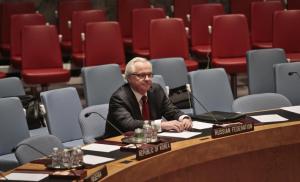Subsidies to the regions. Vampire regions
16:06 — REGNUM The State Duma adopted the federal budget for 2018–2020 in the third reading. For the first time, subsidies have been distributed to balance 73 regional budgets. As the correspondent reports IA REGNUM November 24, this follows from the forecast of the tripartite commission on interbudgetary relations, which includes representatives of the government of the Russian Federation, the State Duma and the Federation Council.
According to the forecast of the tripartite commission on interbudgetary relations, the smallest deficit in 2018 will be recorded in the Smolensk region (186.3 million rubles). The top three regions with the smallest deficit in 2018 will also include the Kirov region (211.5 million rubles) and the Ulyanovsk region (223.6 million rubles).
Meanwhile, the budget deficits of ten regions of the Russian Federation turned out to be more than 3 billion rubles. Among them are the Kostroma Region (3.1 billion rubles), Transbaikal Territory (3.2 billion rubles), Karelia (3.4 billion rubles), Altai Territory (3.4 billion rubles), Udmurtia (3.8 billion rubles), Volgograd region (4 billion rubles) and Stavropol Territory (4.2 billion rubles).
The three regions with the largest deficit include the Penza region, whose deficit will amount to 4.2 billion rubles. The budget deficit of the Omsk region will reach the mark of 7.5 billion rubles. The largest deficit is predicted in the budget of Chechnya - according to the calculations of the tripartite commission, it will reach 9.8 billion rubles.
Subsidies for salaries of public sector employees
The Federal Budget Law for 2018 distributes more than 100 billion rubles between regions. Members of the tripartite commission agreed on this during the consideration of the draft state estimate in the second reading. As the Deputy Chairman of the State Duma said: Alexander Zhukov(“United Russia”), 73 regional budgets will receive subsidies.
According to the decision of the tripartite commission, the bulk of subsidies will be used to increase wages for public sector workers in 2018. Thus, the Omsk region will receive the largest amount of subsidies - an additional 8.6 billion rubles will go to the regional budget. 5.3 billion rubles each will go to the Penza region and the Stavropol Territory. Another approximately 5 billion rubles will be transferred to the budget of the Volgograd region. Udmurtia, Karelia and the Altai Territory will receive about 4 billion rubles to pay salaries to state employees. The top ten leaders that received the largest amount of subsidies also included the Trans-Baikal Territory (3.6 billion rubles), the Kostroma Region (3.4 billion rubles) and the Tambov Region (2.8 billion rubles).
The list of regions in terms of subsidies is closed by the Chukotka Autonomous Okrug, which will receive 112.1 million rubles, Kalmykia, whose budget will receive 110.2 million rubles, and the Jewish Autonomous Region, which will receive 72.4 million rubles.
Among the regions to which no additional subsidies are planned to be sent from the federal budget in 2018 are Moscow and the Moscow region, St. Petersburg and the Leningrad region, the Nenets, Yamalo-Nenets and Khanty-Mansi Autonomous Okrugs, Tataria, as well as Samara, Sverdlovsk , Tyumen and Sakhalin regions.
Ten poor and rich
According to the forecast of the tripartite commission, the leader in tax and non-tax revenues in 2018 will be the city of Moscow, whose budget will receive 2.1 trillion rubles. The top three are also the Moscow region (income 531.1 billion rubles) and the city of St. Petersburg (524.8 billion rubles). About 302.1 billion rubles of income are expected in the Khanty-Mansi Autonomous Okrug, about 262.1 billion rubles in the Sverdlovsk region, 261.4 billion rubles in the Krasnodar Territory. According to the forecasts of the tripartite commission, the budget of Tatarstan will receive 259.6 billion rubles, the Krasnoyarsk Territory - 237.9 billion rubles, and the Yamalo-Nenets Autonomous Okrug - 197.5 billion rubles. These same regions, according to the commission’s forecasts, will become leaders in spending in 2018.
The ten regions with the lowest budget revenues will include the Republic of Ossetia and the Nenets Autonomous Okrug, whose revenues are expected to reach 17.0 billion rubles in both regions. The budget of the Republic of Adygea will receive 12.8 billion rubles, the city of Sevastopol will be able to collect only 11.7 billion rubles. Meanwhile, the income of some constituent entities of the Russian Federation will be less than 10 billion rubles. Among them are the Karachay-Cherkess Republic (9.4 billion rubles), the Jewish Autonomous Okrug (7.9 billion rubles) and the Republic of Tuva (7.2 billion rubles). According to the commission’s forecasts, the three regions with the smallest incomes in 2018 included Kalmykia (7.1 billion rubles), Altai (6.1 billion rubles) and Ingushetia (5.6 billion rubles).
Subsidies to Russian regions in 2019 will exceed 645 billion rubles, which is 5% more than last year. At the same time, the government will use a differentiated approach - 13 regions will receive half of all transfers. In addition, officials intend to solve the problem of excessive debt burden on regional budgets. Also next year, the government will switch to a new principle for calculating financial support.
Next year, total subsidies to Russian regions will reach 645.1 billion rubles, the Ministry of Finance emphasizes. The head of the department, Anton Siluanov, notes a decrease in interest rates on new loans for the regions. This figure will not exceed the Central Bank discount rate (9.25%). At the same time, the Ministry of Finance will switch to a new methodology for calculating the necessary subsidies, which will solve the problem of the debt burden.

In 2019, the next edition of the methodology for determining the resources necessary to equalize budgetary security comes into force. As a result, the Ministry of Finance limited the increase in subsidies for the regions compared to last year. According to the approved changes, this figure cannot exceed 20%. In addition, when calculating the final amount of subsidies, officials will take into account the existing debt burden (including the cost of servicing debts).
The Ministry of Finance emphasizes that the new methodology for calculating subsidies takes into account the change in the structure of the income tax, as a result of which regional budgets lost 1% in favor of the state treasury.
The 5% increase in subsidies to Russian regions in 2019 significantly lags behind last year’s figures, experts emphasize. In 2017, the government increased support for the regions by 20%, and a year earlier by 10.9%. In general, subsidies to the regions have been growing over the past six years. At the same time, the top three in receiving budget funds remains unchanged.
Distribution of government support
Traditionally, the largest recipient of subsidies remains Dagestan, which will receive 59 billion rubles from the state treasury. Compared to last year, the republic’s budget will receive 6.6 billion rubles more. Yakutia remains in second place - total subsidies are about 44 billion rubles. The Kamchatka Territory closes the top three with more than 39 billion rubles.
These regions remain significantly dependent on financial support from the government; subsidies provide up to 40% of budget revenues. In addition, the following regions continue to be classified as highly subsidized:
At the same time, 84% of Chechnya’s budget revenues consist of various transfers from the federal center. The same figure for Crimea is 67%.
The Ministry of Finance notes that financial support for some regions will be significantly reduced in 2019. Moreover, the following regions should not count on transfers from the federal budget:
- Moscow;
- Saint Petersburg;
- Sverdlovsk region;
- Khanty-Mansi Autonomous Okrug;
- Tatarstan;
- Samara Region.
Changing the principle of calculating subsidies will reduce the debt burden of the regions. Earlier, Russian President Vladimir Putin spoke about the need to resolve this issue.

Financial prospects of the regions
The economic crisis has become a real test for regional budgets. If the federal budget deficit was covered by accumulated reserves, then regional authorities could only count on attracting debt resources. As a result, servicing the accumulated debt began to “eat up” a significant portion of regional budget revenues.
After the recovery in oil prices, the state treasury received an additional influx of financial resources. The main source of income for the regions remains personal income tax and income tax, which depend on the resumption of pre-crisis rates of economic growth.
To improve the financial situation of the regions, the government plans to expand the loan restructuring program. This initiative was made by Vladimir Putin, emphasizing the need to improve the regional financial system. Otherwise, the implementation of many social programs will be at risk.
A large-scale loan restructuring program will be launched in 2019. The new initiative of the authorities will last for 7 years. As a result, the regions will be able to free up additional financial resources necessary to finance expenditures. At the same time, the key indicator will be the efficiency of using federal budget funds, which can extend the duration of the preferential program to 12 years.
Next year, subsidies to the regions will be increased by 5% and will reach 645 billion rubles. The amount of government support will depend on the debt burden on regional budgets. In addition, the Ministry of Finance limited the growth of subsidies for the regions compared to last year - this figure cannot be more than 20%.
The largest subsidies from the state treasury will be received by Dagestan, Yakutia and the Kamchatka Territory. Some regions do not experience financial difficulties and will remain without subsidies.
Next year, officials plan to launch a large-scale debt restructuring program, which will solve the problem of debt overload of regional budgets.
Look video on the allocation of 104 billion rubles from the country’s budget for subsidies to the regions:
Subsidies from the Russian federal budget to the regions for 2019: Table
| Region | billion rubles |
| The Republic of Dagestan | 59,07 |
| The Republic of Sakha (Yakutia) | 43,94 |
| Kamchatka Krai | 39,36 |
| Altai region | 27,13 |
| Chechen Republic | 27,08 |
| Stavropol region | 19,20 |
| The Republic of Buryatia | 18,30 |
| Republic of Crimea | 17,71 |
| Republic of Bashkortostan | 16,43 |
| Tyva Republic | 15,73 |
| Rostov region | 13,85 |
| Kurgan region | 13,00 |
| Bryansk region | 12,81 |
| Transbaikal region | 12,13 |
| Ivanovo region | 11,64 |
| Kabardino-Balkarian Republic | 11,09 |
| Kirov region | 10,01 |
| Chuvash Republic – Chuvashia | 9,92 |
| Chukotka Autonomous Okrug | 9,77 |
| Altai Republic | 9,65 |
| The Republic of Ingushetia | 9,20 |
| Karachay-Cherkess Republic | 9,13 |
| Tambov Region | 9,11 |
| Republic of North Ossetia–Alania | 8,98 |
| Arhangelsk region | 8,82 |
| Krasnodar region | 8,74 |
| Republic of Karelia | 8,54 |
| Primorsky Krai | 8,52 |
| Saratov region | 8,50 |
| Volgograd region | 8,29 |
| Chelyabinsk region | 7,59 |
| Kemerovo region | 7,22 |
| Voronezh region | 7,01 |
| Khabarovsk region | 6,77 |
| Penza region | 6,68 |
| Omsk region | 6,58 |
| Mari El Republic | 6,03 |
| Irkutsk region | 5,85 |
| Oryol Region | 5,73 |
| Vladimir region | 5,58 |
| Novosibirsk region | 5,56 |
| Magadan Region | 4,98 |
| Pskov region | 4,29 |
| Tomsk region | 4,15 |
| Tver region | 4,08 |
| Orenburg region | 3,97 |
| Nizhny Novgorod Region | 3,93 |
| Republic of Kalmykia | 3,84 |
| Republic of Adygea (Adygea) | 3,80 |
| Kursk region | 3,77 |
| Kostroma region | 3,70 |
| Udmurt republic | 3,63 |
| Amur region | 3,60 |
| Ryazan Oblast | 3,47 |
| Ulyanovsk region | 3,35 |
| Smolensk region | 3,25 |
| Krasnoyarsk region | 3,19 |
| The Republic of Khakassia | 3,09 |
| The Republic of Mordovia | 2,76 |
| Vologda Region | 2,73 |
| federal city of Sevastopol | 2,60 |
| Astrakhan region | 2,42 |
| Belgorod region | 2,37 |
| Perm region | 2,19 |
| Kaliningrad region | 2,17 |
| Jewish Autonomous Region | 1,89 |
| Tula region | 1,85 |
| Novgorod region | 1,31 |
| Lipetsk region | 0,79 |
| Yaroslavl region | 0,69 |
| Murmansk region | 0,47 |
| Komi Republic | 0,30 |
| Kaluga region | 0,27 |
| Republic of Tatarstan (Tatarstan) | 0,00 |
| Leningrad region | 0,00 |
| Moscow region | 0,00 |
| Samara Region | 0,00 |
| Sakhalin region | 0,00 |
| Sverdlovsk region | 0,00 |
| Tyumen region | 0,00 |
| federal city Moscow | 0,00 |
| federal city of St. Petersburg | 0,00 |
| Nenets Autonomous Okrug | 0,00 |
| Khanty-Mansiysk Autonomous Okrug – Ugra | 0,00 |
| Yamalo-Nenets Autonomous Okrug | 0,00 |
Salikhbek Abdulmanapov
To cover the “budget hole,” the republic had to either take out a budget loan or receive additional funding. The policy of the Ministry of Finance of the Russian Federation, as reported by RBC, involves refusing to issue budget loans and increasing subsidies to the regions, which is associated with an increase in financial injections into the regions. Caucasus expert at MGIMO, RAS Akhmet Yarlykapov told Mirmol that an increase in subsidies is not a factor in improving the economic situation: “In order to launch the economy of Dagestan, mere injections are not enough; it is necessary to make the injections reasonable, to make them work. To do this, something needs to change. I think that a significant part of this amount will go to cover debts. There are a lot of debts. Dagestan’s debt exceeds twenty billion rubles, the budget is “bursting at the seams”, there are debts on salaries and more. The Nogai region alone has debts of more than one hundred million rubles. Of course, increased funding for the republic is not superfluous, but in order for the economy of Dagestan to work and be effective, simply injections are not enough. It is necessary that new financing not only cover debts, but also make the economy itself operate profitably.” 
Akhmet Yarlykapov
“Dagestan has an extremely closed system of distributing budget funds and extracting budget rent,” says senior researcher at RANEPA Konstantin Kazenin, “and if it is not changed, no increase in budget revenues to the republic will change anything, they can only slightly reduce intra-elite tension, because that the struggle between different groups of elites will not be so tough. Ordinary Dagestanis no longer expect anything from the very fact of receiving money; they expect more changes in the practice of governing the republic.” 
Konstantin Kazenin
Shakhmardan Muduev, a leading researcher at the Research Institute of UEPS DGUNKh, is against increasing subsidies. “I am against increasing subsidies, given the history of subsidies over the past period. Subsidies weaken the business community and bureaucrats, creating conditions for the development of corruption. On the other hand, Dagestan cannot do without federal assistance. Equalizing financial security per capita is the right thing to do, but only if the funds are poured into the social sphere: education, healthcare, culture. But 6 billion is a small amount for these purposes.” The main factor in the rational use of allocated funds, as Muduev said, is strict control over the direction of subsidies. 
Shakhmardan Muduev
Vladimir Vasiliev undertook to monitor all allocated funds during his speech in the State Duma: “I am ready to report with some regularity to the hall, to the committee, which I greatly respect, on the expenditure of funds, so that every ruble that will be allocated - I told this to my colleagues from the leadership Dagestan, this is people’s money - we will be responsible for it.” Highly subsidized regions also include Yakutia, Kamchatka Territory, Altai Territory and Chechnya. In total, these five subjects will receive 30% of all subsidies.", "Russian Female");" type="button" value="🔊 Listen to the news"/>!}
Dagestan will become the largest recipient of subsidies in 2018 and will receive more than 59 billion rubles in 2018, which is 6.6 billion more than the funding of the previous period.
The population of the republic is 2.9 million people. With an increase in subsidies, per capita support from the federal budget will be about 20 thousand rubles per person. The need to increase subsidies to the region was stated by the acting head of Dagestan, Vladimir Vasiliev, at a meeting of the State Duma. “Today the Republic of Dagestan has the lowest per capita support from the federal budget,” Vasiliev noted.
Mirmol asked experts in the field of economics and Caucasus studies for what purposes the additional funds could be used.
“The allocated funds will be used to cover the budget deficit and return the previously allocated budget loan,” Salikhbek Abdulmanapov, director of the Research Institute of UEPS DGUNKh, Doctor of Economic Sciences, told a Mirmol correspondent. “The budget deficit was supposed to be covered by the sale of gas networks, but today,” according to Abdulmanapov, “gas networks are not ready for sale.”

Salikhbek Abdulmanapov
To cover the “budget hole,” the republic had to either take out a budget loan or receive additional funding. The policy of the Ministry of Finance of the Russian Federation, as reported by RBC, involves refusing to issue budget loans and increasing subsidies to the regions, which is associated with an increase in financial injections into the regions.
Caucasus expert at MGIMO, RAS Akhmet Yarlykapov told Mirmol that an increase in subsidies is not a factor in improving the economic situation: “In order to launch the economy of Dagestan, mere injections are not enough, it is necessary to make the injections reasonable, to make them work. To do this, something needs to change. I think that a significant part of this amount will go to cover debts. There are a lot of debts. Dagestan’s debt exceeds twenty billion rubles, the budget is “bursting at the seams”, there are debts on salaries and more. The Nogai region alone has debts of more than one hundred million rubles. Of course, increased funding for the republic is not superfluous, but in order for the economy of Dagestan to work and be effective, simply injections are not enough. It is necessary that new financing not only cover debts, but also make the economy itself operate profitably.”

Akhmet Yarlykapov
“Dagestan has an extremely closed system of distributing budget funds and extracting budget rent,” says senior researcher at RANEPA Konstantin Kazenin, “and if it is not changed, no increase in budget revenues to the republic will change anything, they can only slightly reduce intra-elite tension, because that the struggle between different groups of elites will not be so tough. Ordinary Dagestanis no longer expect anything from the very fact of receiving money; they expect more changes in the practice of governing the republic.”

Konstantin Kazenin
Shakhmardan Muduev, a leading researcher at the Research Institute of UEPS DGUNKh, is against increasing subsidies. “I am against increasing subsidies, given the history of subsidies over the past period. Subsidies weaken the business community and bureaucrats, creating conditions for the development of corruption. On the other hand, Dagestan cannot do without federal assistance. Equalizing financial security per capita is the right thing to do, but only if the funds are poured into the social sphere: education, healthcare, culture. But 6 billion is a small amount for these purposes.” The main factor in the rational use of allocated funds, as Muduev said, is strict control over the direction of subsidies.

Shakhmardan Muduev
Vladimir Vasiliev undertook to monitor all allocated funds during his speech in the State Duma: “I am ready to report with some regularity to the hall, to the committee, which I greatly respect, on the expenditure of funds, so that every ruble that will be allocated - I told this to my colleagues from the leadership Dagestan, this is people’s money - we will be responsible for it.”
Highly subsidized regions also include Yakutia, Kamchatka Territory, Altai Territory and Chechnya. In total, these five entities will receive 30% of all subsidies.
Many families in Dagestan have large families. The purpose of paying child benefits in Makhachkala is to provide support to families in need.
Federal transfers in the Republic of Dagestan in 2019
Child benefit in 2019 in Dagestan is paid according to a two-tier system: from the federal and republican budgets. The entire range of federal benefits is reflected in Law No. 81-FZ. A small increase occurred in February 2017.
There are increasing coefficients in the republic. The indicator is 1.1-1.3 for workers who work in high mountain areas.
Amounts of federal payments:
| Payment name | Size (RUB) | Nuances |
| Encouragement for | 613,44 | |
| Payment in case of pregnancy and childbirth | 35 901,37 | |
| One-time | 16,350.33 - minimum transfer; 266,191.80 - maximum payment for 140 days of maternity leave | When triplets are born, transfers are made for each baby. Additional social support measures are determined by local authorities. |
| Minimum | 3,065.69 - for the first baby; 6,131.37 - for the second | Paid up to 1.5 years |
| Pay | 2 527,06 | |
| Transfer to parents of children with disabilities who are unable to work | 5 500; 1200 due to other persons | |
| Payment to mothers laid off due to the liquidation of the enterprise | 613,14 | |
| Monthly transfer to women laid off due to company closure | 50 | Transferred up to three years |
| One-time transfer to the pregnant wife of a conscript employee | 25 892,45 | |
| Pay | 11 096,76 | Transferred every month |
| Regular transfers for children of military personnel who died in the line of duty | 2 231,85 | |
| Annual benefit for children of military personnel killed in military operations in the North Caucasus | 22 027,02 | |
| One-time payment for citizens who have the Order of Parental Glory | 100 000 | |
| 453 026 | ||
| Adoptive family | ||
| 16 350,33; 124,929.83 - if a family accepts a child with a disability | ||
| Benefits for adopted children under 12 years of age | 7 200 | |
| Payment for children from 12 to 18 years old | 8000 | |
Required documents
| Basic package | Additional information |
| Statement Certificate from the registry office about the birth of a baby Birth certificate Marriage document Certificate from the second parent | A document from housing authorities confirming that the baby lives with his mother or father A document stating that the family income is less than the subsistence level Certificates of guardianship Extracts from the last place of work for unemployed citizens Additional payments for children in Dagestan
Additional benefits are provided to women when their fifth child is born. An allowance is due for each subsequent child. Social assistance is provided to those citizens who really need it. Grounds for providing additional social guarantees:
In each of these cases you can count on help. As a rule, the birth or adoption of children with disabilities is recognized as a difficult life situation. Natural and adoptive parents are entitled to additional transfers. Download for viewing and printing: Support for large families in Dagestan
|
 The procedure for paying child benefits is approved by regional legislation:
The procedure for paying child benefits is approved by regional legislation:












